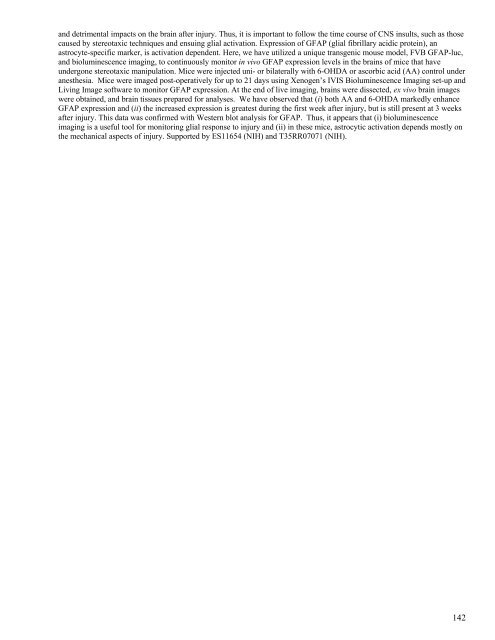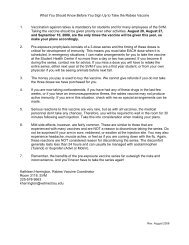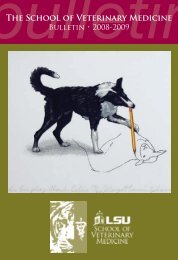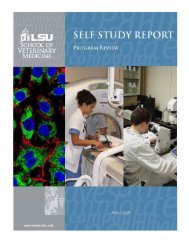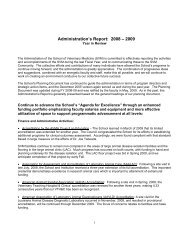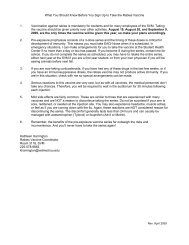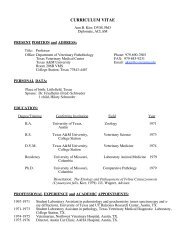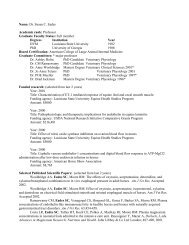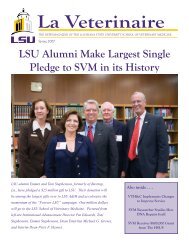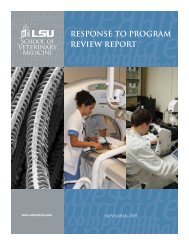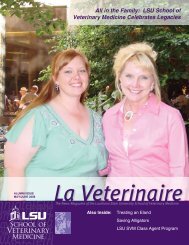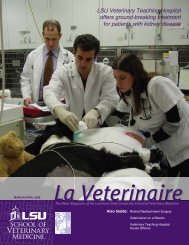- Page 1 and 2:
2006 MERCK/MERIALNATIONAL VETERINAR
- Page 6 and 7:
3:00-3:30 pm BreakNovel therapy for
- Page 8 and 9:
KEYNOTE SPEAKERRonald Veazey, D.V.M
- Page 10 and 11:
Mini Symposium II:Fish Research: A
- Page 12 and 13:
David G. Baker, D.V.M., M.S., Ph.D.
- Page 14 and 15:
Konstantin G. Kousoulas, Ph.D.Profe
- Page 16 and 17:
Joseph Francis, B.V.Sc., M.V.Sc., P
- Page 18 and 19:
dogs with cancer, the potential rol
- Page 20 and 21:
2006 MERCK/MERIALVETERINARY SCHOLAR
- Page 22 and 23:
YOUNG INVESTIGATOR AWARD HONORABLE
- Page 24 and 25:
Mammary epithelial-specific deletio
- Page 26 and 27:
2006 MERCK/MERIALVETERINARY SCHOLAR
- Page 28:
Variation in Q-Tract Length of the
- Page 34:
Novel therapy for humoral hypercalc
- Page 38:
ALTERNATE:Micron-scale membrane sub
- Page 42 and 43:
ABSTRACT TITLES LISTED BY CATEGORY
- Page 44 and 45:
19. A pilot study of cigarette smok
- Page 46 and 47:
36. Development of a murine in vitr
- Page 48 and 49:
ABSTRACT TITLES LISTED BY CATEGORY
- Page 50 and 51:
71. Identification and characteriza
- Page 52 and 53:
85. Age and Gender Influence Ventil
- Page 54 and 55:
ABSTRACT TITLES LISTED BY CATEGORY
- Page 56 and 57:
2006 MERCK/MERIALVETERINARY SCHOLAR
- Page 58 and 59:
10. Preliminary estimation of risk
- Page 60 and 61:
ABSTRACT TITLES LISTED BY CATEGORY
- Page 62 and 63:
47. Osteoprotegerin and Receptor Ac
- Page 64 and 65:
61. A Comparison of Interaction Pat
- Page 66 and 67:
ABSTRACT TITLES LISTED BY CATEGORY
- Page 68 and 69:
ABSTRACT TITLES LISTED BY CATEGORY
- Page 70 and 71:
ABSTRACT TITLES LISTED BY CATEGORY
- Page 72 and 73:
2006 MERCK/MERIALVETERINARY SCHOLAR
- Page 74 and 75:
used to label avian heterophils for
- Page 76 and 77:
obtained via analysis of time and d
- Page 78 and 79:
0.71mg/dL; p=0.001). Values for hem
- Page 80 and 81:
mass and fecundity in prespawning w
- Page 82 and 83:
Equine Hoof Laminae Tissue Collecti
- Page 84 and 85:
Aspiration Pneumonia in DogsDavid A
- Page 86 and 87:
Distortion Product Otoacoustic Emis
- Page 88 and 89:
tyrosine phosphorylation is measure
- Page 90 and 91:
the gravid and non-gravid females t
- Page 92 and 93: egulatory function as its ortholog,
- Page 94 and 95: PATHOLOGY, TOXICOLOGY, AND ONCOLOGY
- Page 96 and 97: Markers of Oxidative Stress in plas
- Page 98 and 99: has been isolated from all samples
- Page 100 and 101: Matrix metalloproteinase secretion
- Page 102 and 103: Reproductive performance, neonatal
- Page 104 and 105: control to determine the efficiency
- Page 106 and 107: Enhancing the Quality and Reliabili
- Page 108 and 109: grade II MCTs into groups with good
- Page 110 and 111: Transcriptional Regulation of the I
- Page 112 and 113: MICROBIOLOGY AND IMMUNOLOGY (SESSIO
- Page 114 and 115: colonization of the mutant and 6 re
- Page 116 and 117: digestive tracts of these and other
- Page 118 and 119: 100 pfu BRSV. The results show that
- Page 120 and 121: Inhibition of Microneme Secretion i
- Page 122 and 123: Adherent bacilli were present in th
- Page 124 and 125: isolated to analyze cytokine gene e
- Page 126 and 127: purified, viral RNA was extracted a
- Page 128 and 129: The effects of co-engagement of TLR
- Page 130 and 131: Occurrence of Leptospira Vaccine Fa
- Page 132 and 133: undifferentiated catecholaminergic
- Page 134 and 135: the concept that the greater detoxi
- Page 136 and 137: quantitative PCR using gene targets
- Page 138 and 139: Rotenone Induced Dopamine Neuron De
- Page 140 and 141: decrease in serum cortisol, with a
- Page 144 and 145: actions of cells prior to embryo de
- Page 146 and 147: Utilizing cDNA Subtraction to Exami
- Page 148 and 149: expression in unilaterally pregnant
- Page 150 and 151: Salmonella is increased. Poultry sa
- Page 152 and 153: exports. The estimated prevalence o
- Page 154 and 155: eeding grounds near Minnedosa, MB s
- Page 156 and 157: (PBMC) were isolated using commerci
- Page 158 and 159: 2006 MERCK/MERIALVETERINARY SCHOLAR
- Page 160 and 161: Trainees acquire in-depth knowledge
- Page 162 and 163: comparative pathology and/or resear
- Page 164 and 165: Department of Veterinary Bioscience
- Page 166 and 167: PhD, Director, Center for Comparati
- Page 168 and 169: 2006 MERCK/MERIALVETERINARY SCHOLAR
- Page 170 and 171: MICHIGAN STATEUNIVERSITYJames Crawf
- Page 172: UNIVERSITY OFPENNSYLVANIALindsay Th


